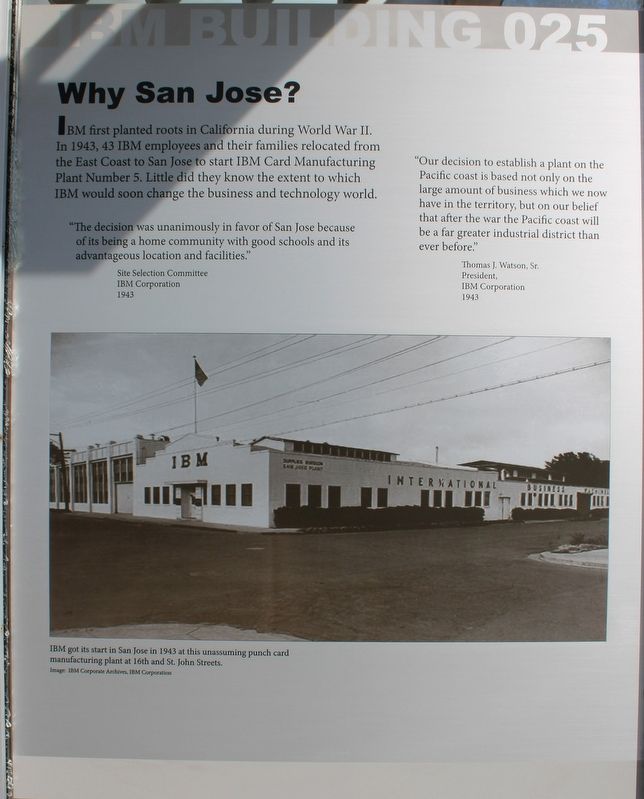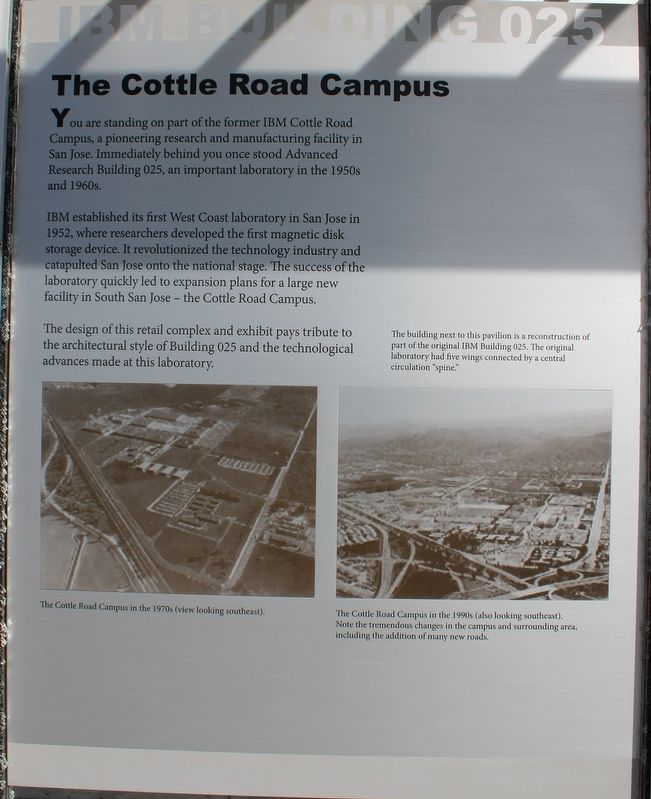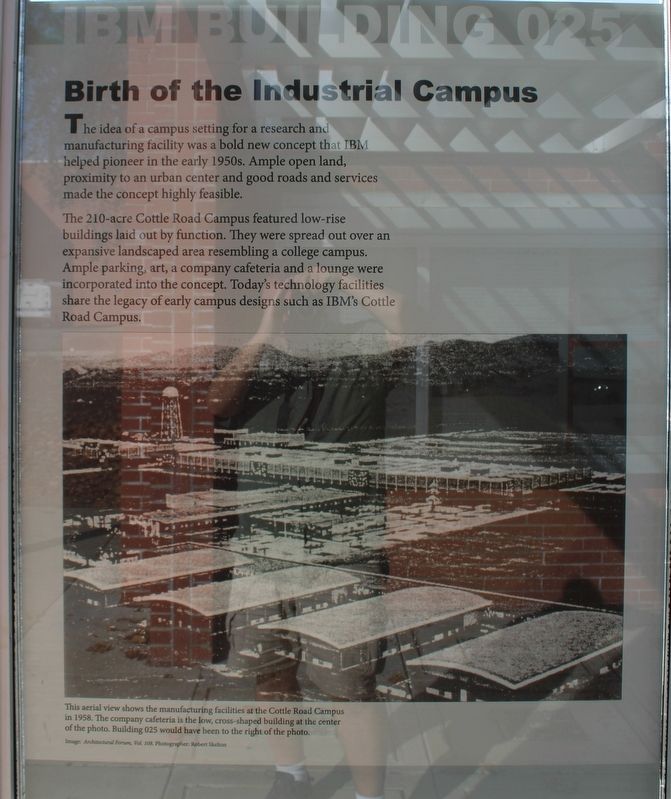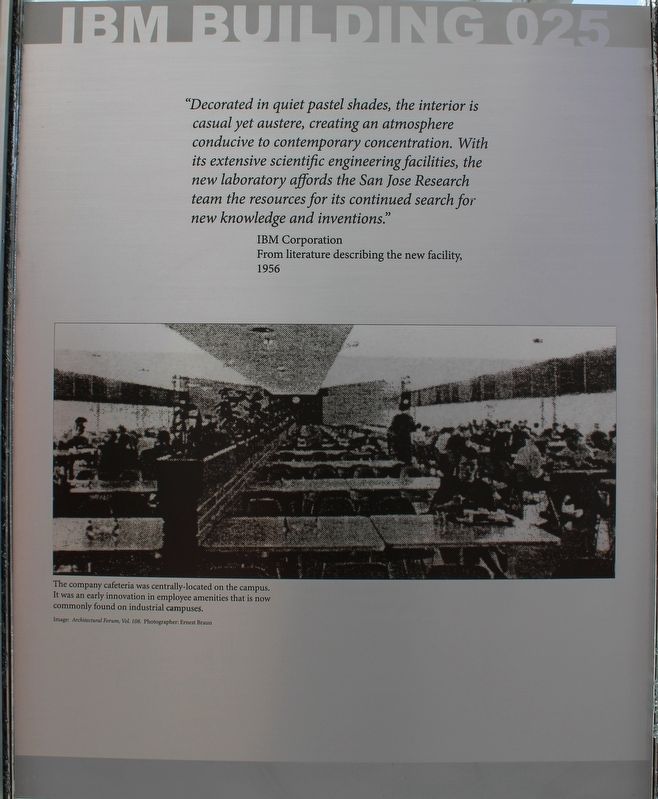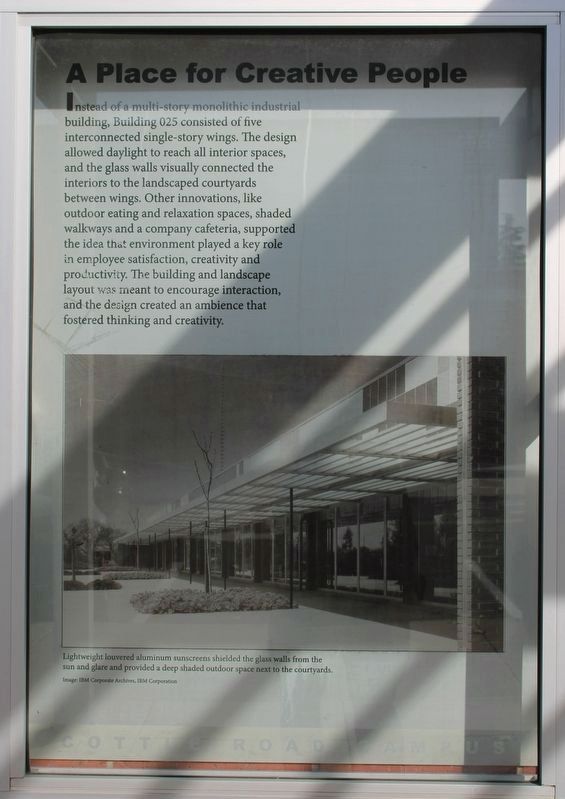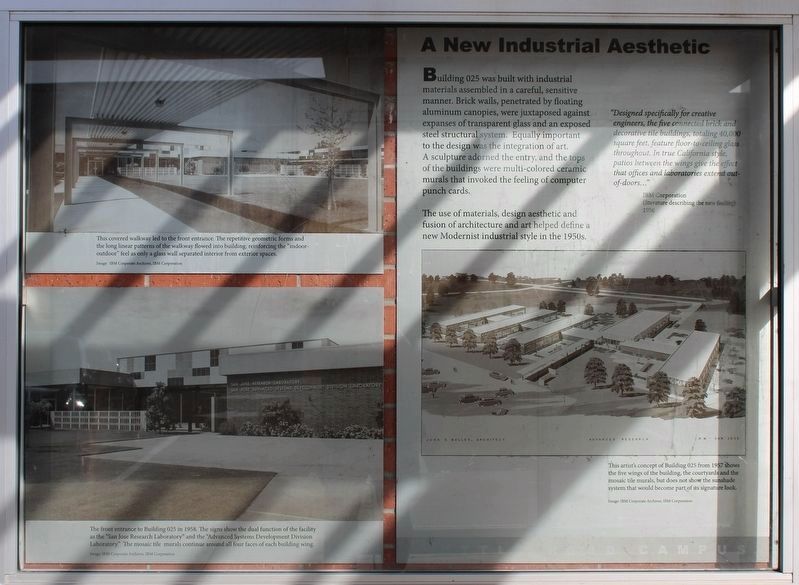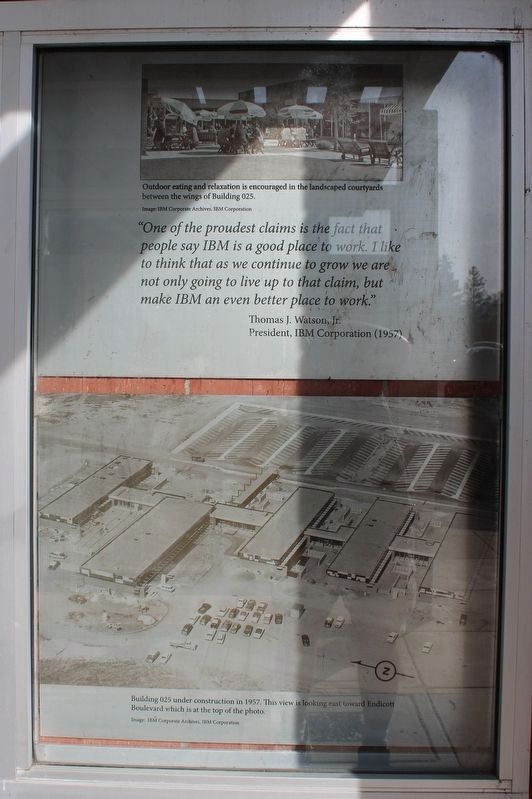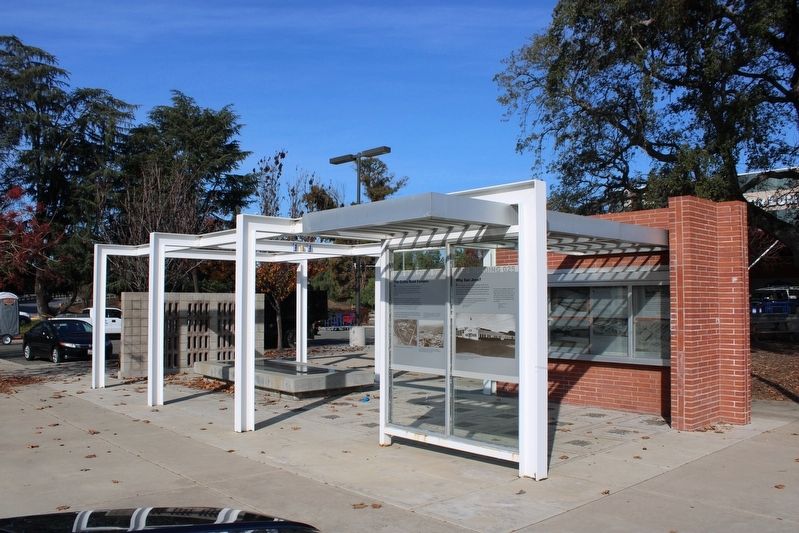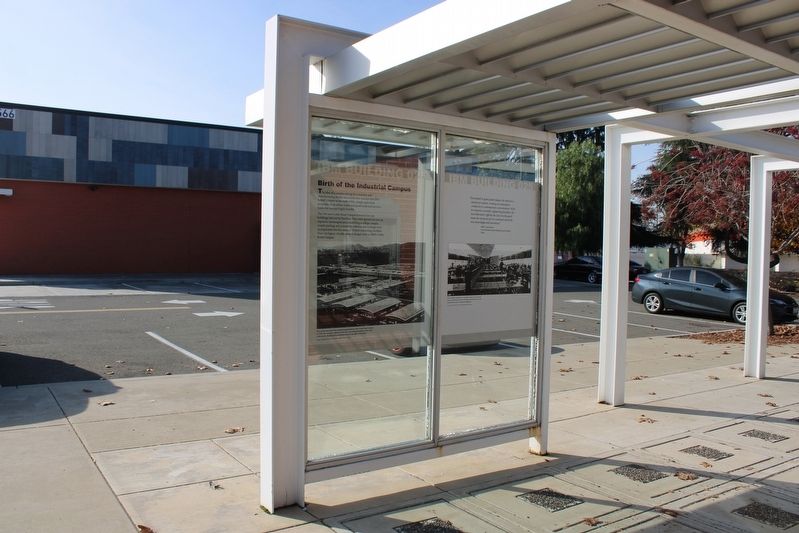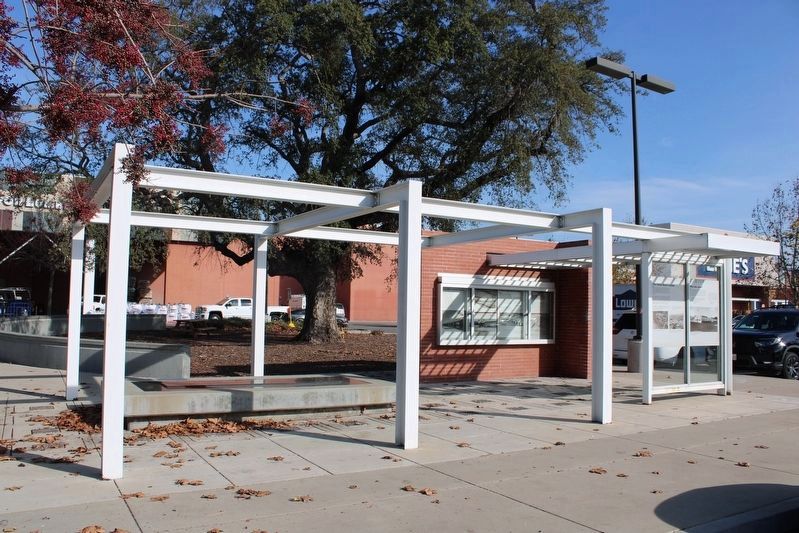Edenvale in San Jose in Santa Clara County, California — The American West (Pacific Coastal)
IBM Building 025
Why San Jose?
IBM first planted roots in California during World War II. In 1943, 43 IBM employees and their families relocated from the East Coast to San Jose to start IBM Card Manufacturing Plant Number 5. Little did they know the extent to which IBM would soon change the business and technology world.
“The decision was unanimous in favor od San Jose because of its being a home community with good schools and its advantageous location and facilities.”
Site Selection Committee, IBM Corporation, 1943
“Our decision to establish a plant on the Pacific coast is based not only on the large amount of business which we now have in the territory, but on our belief that after the war the Pacific coast will be a far greater industrial district than ever before.”
Thomas J. Watson, Sr., President, IBM Corporation, 1943
Image:
IBM got its start in San Jose at this unassuming punch card manufacturing plant at 16th and St. John Streets.
Image: IBM Corporation Archives, IBM Corporation
Panel Two:
The Cottle Road Campus
You are standing on part of the former IBM Cottle Road Campus, a pioneering research and manufacturing facility in San Jose. Immediately behind you once stood Advanced Research Building 025, in important laboratory in the 1950s and 1960s.
IBM established its first West Coast laboratory in San Jose in 1952, where researchers developed the first magnetic disk storage device. It revolutionized the technology industry and catapulted San Jose onto the national stage. The success of the laboratory quickly led to expansion plans for a large new facility in South San Jose – the Cottle Road Campus.
The design of this retail complex and exhibit pays tribute to the architectural style of Building 025 and the technological advances made at this laboratory.
The building next to this pavilion is a reconstruction of part of the original IBM Building 025. The original laboratory had five wings connected by a central circulation “spine.”
Images:
The Cottle Road Campus in the 1970s (view looking southeast).
The Cottle Road Campus in the 1990s (also looking southeast). Note the tremendous changes in the campus and surrounding area, including the addition of many new roads.
Panel Three:
Birth of the Industrial Campus
The idea of a campus setting for a research and manufacturing facility was a bold new concept that IBM helped pioneer in the early 1950s. Ample open land, proximity to an urban center and good roads and services made the concept highly feasible.
The 210-acre Cottle Road Campus featured low-rise buildings laid out by function. They were spread out over an expansive landscaped area resembling a college campus. Ample parking, art, a company cafeteria and a lounge were incorporated into the concept. Today’s technology facilities share the legacy of early campus design such as IBM’s Cottle Road Campus.
Image:
This aerial view shows the manufacturing facilities at the Cottle Road Campus in 1958. The company cafeteria is the low, cross-shaped building at the center of the photo. Building 025 would have been to the right of the photo.
Image: Architectural Forum, Vol. 108. Photographer: Robert Skelton
Panel Four:
”Decorated in quiet pastel shades, the interior is casual yet austere, creating an atmosphere conductive to contemporary concentration. With its extensive scientific engineering facilities, the new laboratory affords the San Jose Research team the resources for its continued search for new knowledge and inventions.”
IBM Corporation, From literature describing the new facility, 1956
Image:
The company cafeteria was centrally-located on the campus. It was an early innovation in employee amenities that is now commonly found on industrial campuses.
Image: Architectural Forum, Vol. 108. Photographer: Ernest Braun
Panel Five:
Instead of a multi-story monolithic industrial building, Building 025 consisted of five interconnected single-story wings. The design allowed daylight to reach all interior spaces, and the glass walls visually connected the interiors to the landscaped courtyards between wings. Other innovations, like outdoor eating and relaxation spaces, shaded walkways and a company cafeteria, supported the idea that environment played a key role in employee satisfaction, creativity and productivity. The building and landscape layout was meant to encourage interaction, and the design created an ambience that fostered thinking and creativity.
Image:
Lightweight louvered aluminum sunscreens shielded the glass walls from the sun and glare and provided a deep shaded outdoor space next to the courtyards.
Image: IBM Corporation Archives, IBM Corporation
Panel Six:
A New Industrial Aesthetic
Building 025 was built with industrial materials assembled in a careful, sensitive manner. Brick walls, penetrated by floating aluminum canopies, were juxtaposed against expanses of transparent glass and an exposed steel structural system. Equally important to the design was the integration of art. A sculpture adorned the entry, and the tops of the buildings were multi-colored ceramic murals the invoked the feeling of computer punch cards.
The use of materials, design aesthetics and fusion of architecture and art helped define a new Modernist industrial style in the 1950s.
”Designed specifically for creative engineers, the five connected brick and decorative tile buildings, totaling 40,000 square feet, featured floor-to-ceiling glass throughout. In true California style, patios between the wings give the effect that offices and laboratories extend out-of-doors…”
IBM Corporation, (literature describing the new facility), 1956
Images:
This artist’s concept of Building 025 from 1957 shows the five wings of the building, the courtyards and the mosaic tile murals, but does not show the sunshade system that would become part of its signature look.
Image: IBM Corporation Archives, IBM Corporation
This covered walkway led to the front entrance. The repetitive geometric forms and the long linear patterns of the walkway flowed into building, reinforcing the “indoor-outdoor” feel as only a glass wall separated interior from exterior spaces.
Image: IBM Corporate Archives, IBM Corporation
The front entrance to Building 025 in 1958. The signs show the dual function of the facility as the “San Jose Research Laboratory” and the “Advanced Systems Development Division Laboratory.” The mosaic tile murals continue around all four faces of each building wing.
Image: IBM Corporate Archives, IBM Corporation
Panel Seven:
”One of the proudest claims is the fact that people say IBM is a good place to work. I like to think that as we continue to grow we are not only going to live up to that claim, but make IBM an even better place to work.”
Thomas J. Watson, Jr., President, IBM Corporation (1957)
Images:
Outdoor eating and relaxation is encouraged in the landscaped courtyards between the wings of Building 025.
Image: IBM Corporate Archives, IBM Corporation
Building 025 under construction in 1957. This view is looking east toward Endicott Boulevard which is at the top of the photo.
Image: IBM Corporate Archives, IBM Corporation
Erected by IBM Corporation.
Topics. This historical marker is listed in this topic list: Industry & Commerce. A significant historical year for this entry is 1943.
Location. 37° 15.191′ N, 121° 48.172′ W. Marker is in San Jose, California, in Santa Clara County. It is in Edenvale. Marker can be reached from Cottle Road south of Endicott Boulevard. The markers are framed in a pavilion. Touch for map. Marker is at or near this postal address: 5566 Cottle Road, San Jose CA 95123, United States of America. Touch for directions.
Other nearby markers. At least 8 other markers are within 2 miles of this marker, measured as the crow flies. New Almaden Quicksilver Mine (approx. 0.8 miles away); Hayes Mansion (approx. 1.1 miles away); a different marker also named Hayes Mansion (approx. 1.2 miles away); Frontier Village (approx. 1.4 miles away); The Bernal-Gulnac-Joice Ranch House (approx. 1.9 miles away); Farm Animals (approx. 1.9 miles away); Chores Around the Ranch House (approx. 1.9 miles away); Welcome to the Bernal-Gulnac-Joice Ranch (approx. 1.9 miles away). Touch for a list and map of all markers in San Jose.
Credits. This page was last revised on February 7, 2023. It was originally submitted on December 20, 2022, by Joseph Alvarado of Livermore, California. This page has been viewed 581 times since then and 260 times this year. Photos: 1, 2, 3, 4. submitted on December 20, 2022, by Joseph Alvarado of Livermore, California. 5, 6, 7. submitted on December 30, 2022, by Joseph Alvarado of Livermore, California. 8, 9. submitted on December 20, 2022, by Joseph Alvarado of Livermore, California. 10. submitted on December 30, 2022, by Joseph Alvarado of Livermore, California.
